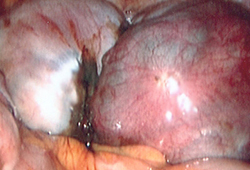შეჯამება
დიფერენციული დიაგნოზები
ხშირი
- Vaginitis and vulvovaginitis
- Herpes simplex infection
- Vaginal atrophy
- Iatrogenic
- Primary inadequate lubrication
- Vestibulodynia/vulvodynia
- Endometriosis
- Adenomyosis
- Leiomyomas
იშვიათია
- Interstitial cystitis
- Urinary tract infections, female
- Bartholin gland abscess
- Seminal plasma hypersensitivity
- Dermatitis, contact
- Dermatitis, atopic
- Bartholin gland mass
- Imperforate hymen
- Traumatic perineal injuries
- Vulvar dystrophies
- Vaginismus
- Psychosexual disorder
- Cervicitis
- Pelvic inflammatory disease
- Hydrosalpinx
- Levator ani spasm
Colaboradores
Autores
Kai J. Buhling, MD, PhD
Professor
Head of Department of Gynecological Endocrinology and Reproductive Medicine
University Hospital Hamburg-Eppendorf
Hamburg
Germany
Declarações
KJB declares that he has no competing interests.
Agradecimentos
Dr Buhling would like to gratefully acknowledge Dr Hans-Joachim Ahrendt, Dr Suketu M. Mansuria and Dr Amy N. Broach, the previous contributors to this topic.
Declarações
SMM declares that he has no competing interests.
Revisores
Lori A. Brotto, PhD, R Psych
Assistant Professor
Department of Obstetrics and Gynecology
University of British Columbia
Vancouver
Canada
Declarações
LAB declares that she has no competing interests.
Katherine E. Bunge, MD
Clinical Instructor
Magee-Womens Hospital
University of Pittsburgh
Pittsburgh
PA
Declarações
KEB declares that she has no competing interests.
Créditos aos pareceristas
Os tópicos do BMJ Best Practice são constantemente atualizados, seguindo os desenvolvimentos das evidências e das diretrizes. Os pareceristas aqui listados revisaram o conteúdo pelo menos uma vez durante a história do tópico.
Declarações
As afiliações e declarações dos pareceristas referem--se ao momento da revisão.
Referências
Principais artigos
IsHak WW, Tobia G. DSM-5 changes in diagnostic criteria of sexual dysfunctions. Reprod Sys Sexual Disorders 2013;2:122.
Lee NMW, Jakes AD, Lloyd J, et al. Dyspareunia. BMJ. 2018 Jun 19;361:k2341.Texto completo Resumo
National Institute for Health and Care Excellence. Endometriosis: diagnosis and management. Nov 2024 [internet publication].Texto completo
Artigos de referência
Uma lista completa das fontes referenciadas neste tópico está disponível para os usuários com acesso total ao BMJ Best Practice.
O uso deste conteúdo está sujeito ao nosso aviso legal

